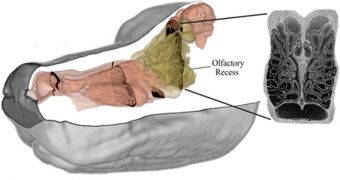In addition to being men's best friends, dogs are also gifted by nature with a sense of smell that is at least a thousand times more keen than our own. This ability they have is being used in a wide array of applications, raging from detecting drugs to testing food for poison or finding victims buried under the rubble following a major natural disaster. In a study that could see the development of new, odor-sensitive, artificial-nose machines, experts managed to model the canine sniffer and determine where their acute sense of smell originates from.
The anatomical structure of a dog's nasal cavity is something that researchers have been aware of for at least five decades. Their sniffers look a lot less like a nose, and more like an intricate maze of airways and recessed cavities, which help circulate, accelerate, slow down, and analyze the streams of air passing through them to great extent. These highly convoluted airways have disappeared completely from primates, including humans, and evolutionary biologists say it's doubtful we ever had them. The olfactory recesses are other highly specialized smell structures that dogs developed.
Located behind the eyes, they occupy up to half of the entire nose cavity in some species, biologists say. Other experts had inferred that the structures might have something to do with the dogs' incredible abilities to smell things that other animals couldn't even perceive clearly. “But no one had looked at how air and odors actually flow inside” the noses before going into the recesses, Pennsylvania State University (Penn State) mechanical engineer Brent Craven reveals. So, he and his team developed a complex computer model for a canine nose, and set out to study these airflows inside it.
“We then had to make our model simulate how dogs sniff,” Craven says. The team had no way of knowing how the animals drew air in, so they installed muzzles in the nostrils of a Pomeranian and a Labrador retriever, to measure just that. They then inserted their data into the computer model, and discovered that, “When a dog sniffs, each nostril pulls in a separate odor sample [and so] the dog can tell which nostril is pulling in the scent,” the expert says. This aids hunting dogs figure out which direction the smell came from, and helps them track down prey, ScienceNow reports.
In a paper recently published in the Journal of the Royal Society Interface, the experts also note that a unique nasal airflow pattern helps canines transport odor molecules to the recesses separately, for processing. Unlike in humans, the airflow is not exhaled when the dog breathes, allowing the animal to keep the scent for longer without the risk of suffocation.

 14 DAY TRIAL //
14 DAY TRIAL //